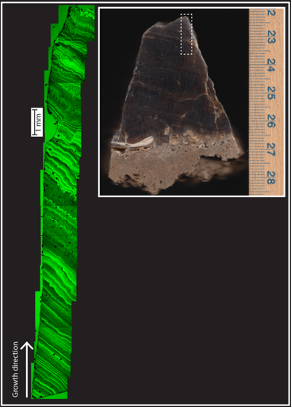By Dilpreet Raju
Medill Reports
Some of the interweaving drivers of Earth’s climate change remain a mystery, but many of the world’s leading paleoclimatologists work every day to fill in the gaps.
Paul Töchterle, a geological Ph.D. candidate at the University of Innsbruck in Austria, is working to revise the methods scientists use to date the age of everything from rock formations to past water levels that provide the clues.
Their findings include evidence about past climate — or paleoclimate — that reveal where the planet is headed today.
“Science definitely has a role of informing the public,” he said.
That information can strengthen support for energy and policy measures to take urgent action in addressing climate change.
Töchterle presented his findings this fall at the annual Comer Climate Conference, a gathering of climate researchers from across the world who share their latest findings that hold implications for agriculture, climate science and overall understanding of the ongoing impacts caused by climate change.
Paleoclimate data gathered predates human records and emissions from fossil fuel use, so techniques such as mass spectrometry fill in the timelines when there were no direct temperature readings or water level measurements to document the planet’s climate in the past.
It’s not so clear-cut to say that “climate has always been changing, so we cannot predict it,” Töchterle said. “Actually, we understand a lot about climate these days, and we know a lot about what the planet would be doing if it wasn’t for anthropogenic emissions.” These are human-driven emissions from the use of fossil fuels.
Mass spectrometry operates by measuring a sample: in Töchterle’s case, drilled carbonate powder from a fallen stalagmite as he searches for climate clues deep inside caverns.
The sample is eventually loaded into the mass spectrometer, which then calibrates the mass and charge of each element and isotope found within the powder. The resulting data can be interpreted as representing climate since the amount of given isotopes change with climate conditions.
Over the course of thousands, even millions, of years, some isotopes degrade.
Researchers mine through data obtained from mass spectrometers to date various cave sites and better understand natural climate variations that should be considered under the umbrella of paleoclimatology work.
Cameron Batchelor, a postdoctoral research fellow at Massachusetts Institute of Technology, has turned her focus toward investigating North America’s seasonal patterns of rainfall by observing layers of banding within mineral deposits formed in caves from groundwater. Like Töchterle, she looks at speleothems, commonly known as stalagmites or stalactites.

“When you cut open a stalagmite, you have the layers that you can see with the eye,” Batchelor said. “I (used) a special method where I look at the fluorescent banding within those layers” to reveal tiny laminations within the calcite that are only microns thick.
Batchelor developed an interest in the field of geology when her older sister found a career in geophysics years ago.
She followed near her sister’s footsteps by getting her M.S. and Ph.D. in geoscience from the University of Wisconsin-Madison, where she studied the Cave of the Mounds, only a 30-minute drive from Madison.
“Pulling out seasonal records is important because even though we know it’s going to get warmer and wetter, we don’t know specifically what seasons are going to be affected,” she said. “Are farmers going to expect more snow, or is wetter going to be flooding during the summer?”
Agricultural production is dependent upon climate, and paleoclimate records of midland precipitation history are scarce, due to fewer rainy seasons the further inland one goes.
“Understanding how seasonality changed across the Holocene — or the last 11,000 years — is really important because it’s the last slice of time before anthropogenic CO2 went into the atmosphere,” Batchelor said. “Understanding how natural variability changed before humans interacted greatly (to change the environment) is important.”
Batchelor works in David McGee’s Lab for Paleoclimate and Geochronology at MIT. The lab members focus on ways to date the planet’s past climate accurately by an assortment of methods; for example, one group tracks wind-blown dust from deserts in order to map wind patterns.
“I eventually found it really fascinating, this challenge of understanding how Earth’s climate has changed in the past and during times that we don’t have any direct data,” McGee said.
“The last half million years have all been, or have mostly been, climates that are colder than today and so they’re interesting,” he said.
But there is potentially even more valuable information from deeper into our planet’s past.
“There’s obviously value in looking at climates warmer than today because that’s where we’re headed,” McGee said. “To do that, we have to go back farther in time. That requires just different methods and dealing with a more fragmentary record.”
Dilpreet Raju is a health, environment and science graduate student at Medill. You can follow him at @DilpreetRaju on Twitter.


